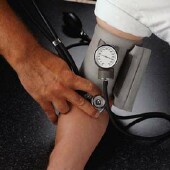
TUESDAY, May 15 (HealthDay News) — “Team-based care” should be used to improve patients’ blood pressure control, the U.S. Task Force on Community Preventive Services recommended on Tuesday.
The recommendation is based on a review of 77 studies that showed improvements in patients’ control of blood pressure when they received care from a team of health professionals — a primary care doctor supported by a pharmacist, nurse, dietitian, social worker, or community health worker — rather than a primary care doctor alone.
The task force found that team-based care increased the percentage of patients with controlled blood pressure, led to a decrease in both systolic (top number) and diastolic (bottom number) blood pressure, and improved results in patients with diabetes and elevated levels of blood fats.
Team members assist primary care doctors by providing support and sharing responsibility for high blood pressure care (such as managing medications), doing patient follow-up, and helping patients stick to their blood pressure control plan. Such a plan includes routinely monitoring blood pressure, taking medications as prescribed, reducing sodium in the diet, and increasing physical activity.
The review found that the greatest improvements in blood pressure occurred when team members could change medications independently or with the approval of the primary care doctor. Improvements were not as great when team members were only permitted to oversee patients’ taking of medications.
“Adoption of this model throughout the United States would improve blood pressure control for the 68 million adult Americans who have high blood pressure and reduce their risk of heart attack, stroke, and other health problems,” Dr. Thomas Frieden, director of the U.S. Centers for Disease Control and Prevention, said in a CDC release.
“This analysis shows that when primary care physicians and other health care professionals with different expertise and approaches work together to support their patients, they can find the right formula for getting blood pressure under control,” he added.
The CDC provides ongoing scientific and other support for the task force, which published its findings in the Guide to Community Preventive Services.
Complete findings from this review are expected to be published in May 2013.
High blood pressure was the main or a contributing cause of approximately 336,000 American deaths in 2007. If all people with high blood pressure were treated under the current clinical guidelines, it’s estimated that 46,000 lives could be saved each year, the CDC said.
Team-based care is a major component of the Million Hearts initiative launched in September 2011 by the U.S. Department of Health and Human Services. The goal of the initiative is to prevent 1 million heart attacks and strokes in the United States over five years.
More information
The U.S. National Heart, Lung, and Blood Institute has more about treating high blood pressure.

